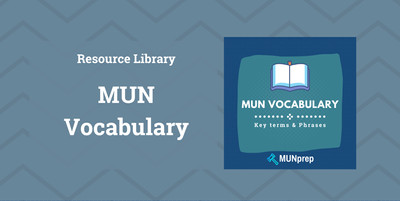Advanced Moderated Caucus Guide

A moderated caucus is one of the most effective tools for shaping debate and building consensus in Model UN. Advanced delegates use these sessions not only to share ideas but also to drive the debate towards a specific direction, highlight key issues, and set the groundwork for resolutions.
This guide will help you refine your strategies to maximize your influence during moderated caucuses.
Our Strategies
Remember the Order of Disruption
The "order of disruption" is the sequence in which motions are considered for a vote, based on how much they interrupt the current flow of committee proceedings. Once the secondary speakers’ list has been opened, motions are prioritized from most to least disruptive in the following way:
- Extensions of previous caucuses—whether moderated or unmoderated—are considered the most disruptive.
- Unmoderated caucuses come next. When there are multiple motions for unmoderated caucuses, the one with the longest proposed duration is seen as the most disruptive.
- Moderated caucuses follow. Among multiple moderated caucus motions, the longest one takes priority. If multiple motions propose the same length, the one with the higher number of speakers (based on speaking time) is considered more disruptive. For example, a 10-minute moderated caucus with 30-second speaking times allows for more speakers and is therefore more disruptive than one with 1-minute speaking times. A 15-minute caucus, regardless of speaking time, is more disruptive than both. If two motions have the same length and number of speakers, the one proposed first is voted on first.
If the most disruptive motion fails during the vote, the committee moves on to the next most disruptive one. All motions submitted at the same time are considered to be "on the floor" and will be addressed in this order of disruption.
Stay Engaged Throughout
No matter what the topic is - keep raising your placard. Take any opportunity to speak and keep your position in the forefront of other delegates mind.
Even if you’re not speaking, pay close attention to other delegates’ arguments, noting which positions align with yours and which ones are potential threats.
Consider The Timing Of Your Motions
Propose Motions Early: As soon as you have an idea of the committee’s direction, propose a motion for a mod to shift the focus toward a topic that benefits your strategy. Don't hang around or the direction of committee might go elsewhere.
Don't be afraid to repeat Motions: Sometimes second time is the charm, if a motion doesn't succeed one time, it can be alright to give it another try during the next wave of motions.
Adapt to the Debate Flow: If you see that the debate is getting off track or stalled, call for a mod that refocuses the discussion. If not many people are suggesting caucuses, feel free to suggest a longer caucus time.
Check out our guide on Points and Motions Here
Framing Your Motions
Mind Your Wording: Sometimes you will want to propose a more general mod (earlier on in committee), other times you will want to propose a more specific mod (later on in committee). Base specific motions that focus on key themes that you have heard being discussed already.
Lead with a Question: If possible, frame the mod as a question:
- “How can funding be improved for rural healthcare initiatives?” This invites responses directly tied to your focus and creates a more engaging debate.
Tie to Draft Resolutions: Propose mods that spotlight parts of your draft resolution. For example:
- “Discussing the feasibility of financial incentives for renewable energy” aligns with clauses in your draft and makes it easier to promote your ideas later.
Don't be afraid to stay general: Not every moderated Caucus needs to be super in-depth, a moderated caucus that helps the committee take account of everyone's position can be much more effective than something that is just too specific. Some examples might include:
- Understanding Member States' General Positions - "Discussing the overall priorities of member states regarding the resolution of the current crisis.
- Identifying Key Challenges - "Exploring the main obstacles preventing progress on the issue at hand."
- Broad Solutions Exploration - "Discussing general categories of solutions that the committee should consider."
- Evaluating Existing Frameworks - "Discussing the effectiveness of existing international agreements or policies related to the topic."
Speaking Strategy
Highlight Key Points: Prepare 2-3 core points that you want to convey clearly within your speaking time. Avoid rambling or introducing too many ideas at once.
Use Facts and Figures: Incorporate statistics or facts to back your arguments. This not only adds credibility but also makes your speech more persuasive and memorable.
Direct Engagement: Address specific delegates or blocs by mentioning their country names when relevant: “Building on the idea presented by France…” This shows attentiveness and helps build alliances.
Control the Narrative: If you’re among the first to speak, set the tone by framing the topic. If you’re later in the list, either build on popular arguments to align with consensus or introduce a new angle that hasn’t been considered.
Check out our guide on Moderated Caucus Speeches Here
Use Moderated Caucuses for Alliance-Building
Support Allies’ Motions: Reinforce trust with your allies by supporting their motions, even if they aren't directly related to your own strategy. This builds credibility as a collaborative delegate.
Use Moderated Caucuses to Set Up Unmoderated Caucuses
Use a mod to lay out key areas that need collaboration during an unmoderated caucus:
- “Based on this discussion, it seems we need a detailed plan for financing. I suggest we have an unmod next to work on a joint draft.”
This ensures that the transition from speaking to writing is smooth, purposeful, and productive.
Using a Moderated Caucus to set up a Q&A Session
Begin by motioning for a separate presentation period followed by a moderated caucus dedicated to Q&A. Clearly outline the timing for both segments.
Learn more about Q&A Sessions here
When Your Caucuses Aren't Passing
Adjusting Strategies Based on Committee Dynamics
Pivot if Necessary: If your initial moderated caucus doesn’t gain traction, adapt to the committee’s dominant themes. You can suggest follow-up mods that connect more with the majority's concerns while subtly guiding the conversation back to your core interests.
Oppose the Power Delegate: If you notice a delegate starting to get significant traction in committee and they are having success in getting their Caucuses pass, start taking positions that diametrically oppose them.
By mastering these advanced strategies, you can not only enhance your individual performance but also drive debate toward meaningful, collaborative outcomes.
Best of luck!






